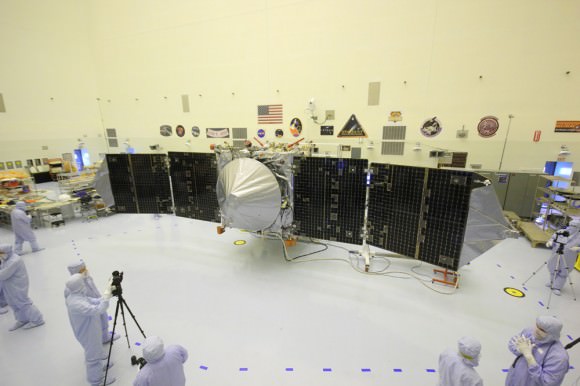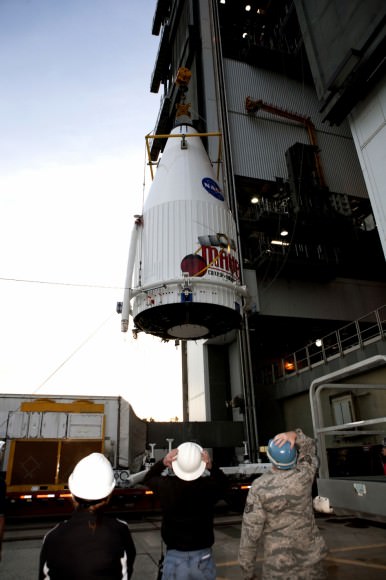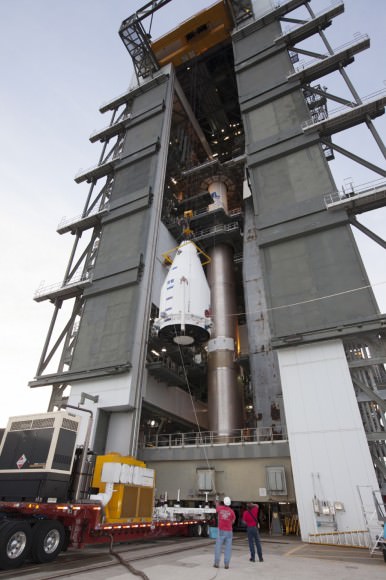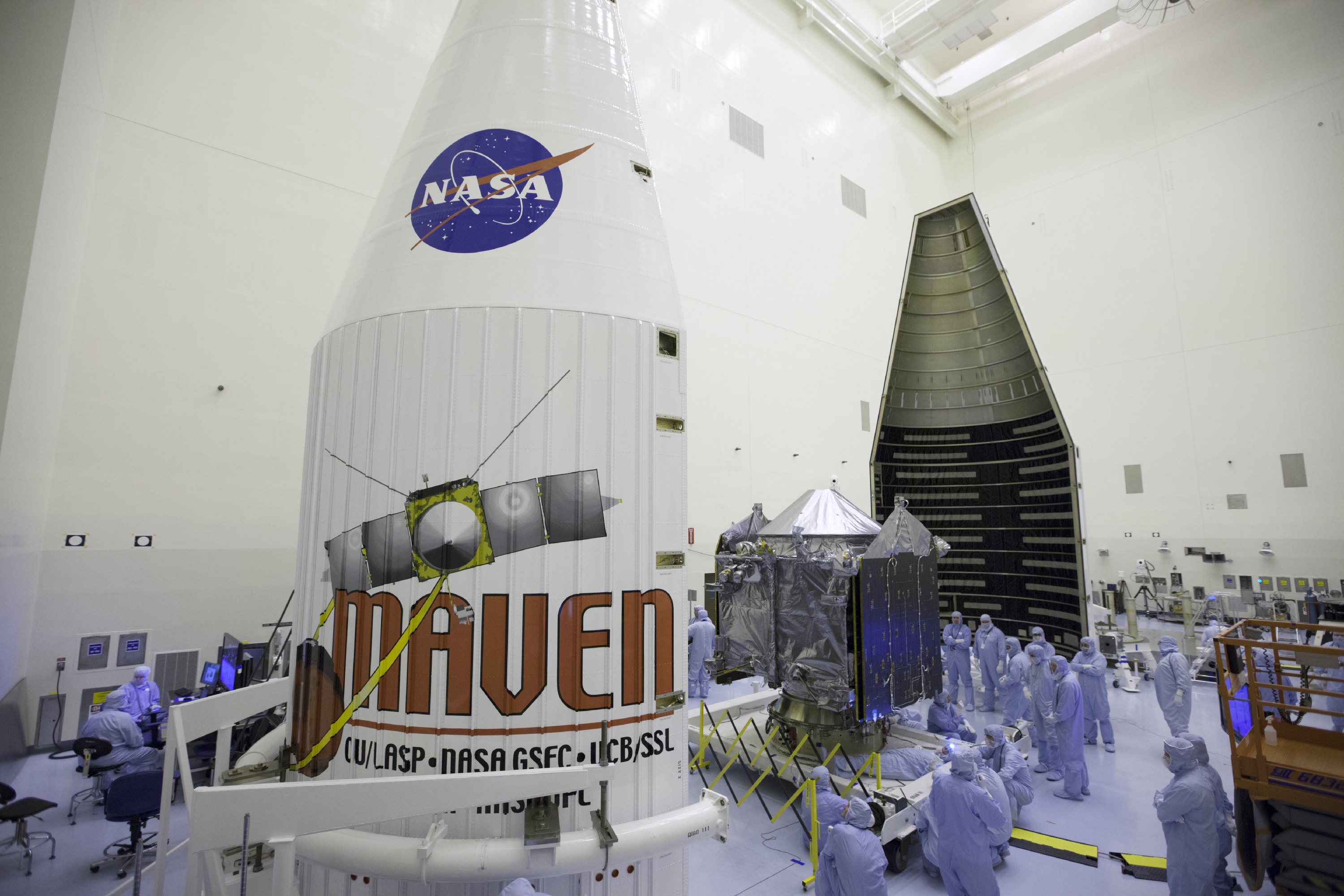KENNEDY SPACE CENTER, FL – MAVEN, NASA’s next spacecraft launching to the Red Planet in barely three days time on Nov. 18 seeks to unlock one of the greatest Martian mysteries; Where did all the water go ?
From the accumulated evidence so far scientists believe that billions of years ago, Mars was gifted with a thick atmosphere like Earth and liquid water flowed across the surface.
The Red Planet was far bluer, warmer, wetter and hospitable to life four billion years ago – truly a lot more Earth-like.
And then Mars lost its atmosphere starting somewhere around 3.5 to 3.7 Billion years ago. As the atmosphere thinned and the pressure decreased, the water evaporated and Mars evolved into the cold arid world we know today.
But why and exactly when did Mars undergo such a radical climatic transformation?
“Where did the water go and where did the carbon dioxide go from the early atmosphere? What were the mechanisms?” asks Bruce Jakosky, MAVEN’s Principal Investigator from the University of Colorado at Boulder

Although there are lots of theories, NASA’s MAVEN Mars orbiter – which stands for Mars Atmosphere and Volatile Evolution – is the first real attempt to investigating these fundamental questions that hold the key to solving the Martian mysteries perplexing the science community.
“We don’t know the driver of the change,” explains Jakosky.

“The major questions about the history of Mars center on the history of its climate and atmosphere and how that’s influenced the surface, geology and the possibility for life,” says Jakosky.
MAVEN is equipped with three instrument suites holding nine science instruments
MAVEN will focus on understanding the history of the atmosphere, how the climate has changed through time, and how that influenced the evolution of the surface and the potential for habitability by microbes on Mars.”
“That’s what driving our exploration of Mars with MAVEN,” said Jakosky
The 5,400 pound MAVEN probe carries nine sensors in three instrument suites.

I personally inspected MAVEN inside the clean room at the Kennedy Space Center on Sept. 27 with fellow journalists when the solar arrays were fully unfurled.
The probe spanned 37 feet in length from wingtip to wingtip.
Since then MAVEN has been folded and encapsulated inside the payload fairing, transported to the pad at Launch Complex 41 and hoisted on top of the Atlas V rocket on Cape Canaveral Air Force Station (CCAFS) in Florida.
The $671 Million MAVEN spacecraft has been powered on and awaits liftoff.
MAVEN is the second of two Mars bound probes launching from Earth this November.
India’s Mars Orbiter Mission (MOM) spacecraft staged a spectacular lift off from the Indian spaceport on Nov. 5. Both probes are due to arrive at the Red Planet in September 2014.
Stay tuned here for continuing MAVEN and MOM news and Ken’s MAVEN launch reports from on site at the Kennedy Space Center press site.
…………….
Learn more about MAVEN, MOM, Mars rovers, Orion and more at Ken’s upcoming presentations
Nov 14-20: “MAVEN Mars Launch and Curiosity Explores Mars, Orion and NASA’s Future”, Kennedy Space Center Quality Inn, Titusville, FL, 8 PM
Dec 11: “Curiosity, MAVEN and the Search for Life on Mars”, “LADEE & Antares ISS Launches from Virginia”, Rittenhouse Astronomical Society, Franklin Institute, Phila, PA, 8 PM


“…Where is Mars water go…?”
(A nursey rhyme in Turkish !)
… A cow has drunk it…
Where is the cow…?
(It has) run to mountain…
Where is the mountain…?
(It has) burned, finished…become ash…
the water and the atmosphere on earth remains on its surface because a few km beneath the surface the water is rejected outwards by the intern heat. this was so on mars too until the internal heat production stopped. by cooling internally it sucked the water to its inside, followed by its atmosphere. ….
so maybe you just have to drill and the water comes out?
“The fact that the heavy isotopes dominate the remaining Martian air means its lighter, high-altitude gases bled away first — supporting the top-down theory.”
Not only, the Solar wind keeps blowing the atmosphere away,
but also, the escape velocity is too low.
I thought that Mar’s atmosphere was blown away by the sun after it lost it’s magnetic shield. This assumes that Mars at one point had an active core producing magnetic shielding.
Hopefully whatever this project finds will help Earthlings inject a bit of sanity and true scientific understanding into the climate change issue.
Exactly, there is likely life on the red planet but it is beneath the surface. NASA has already made theoretical assumptions related to this but proving it is another story. I have no doubt there is life currently on Mars right now, but survival is dependent on sustenance below, not above.